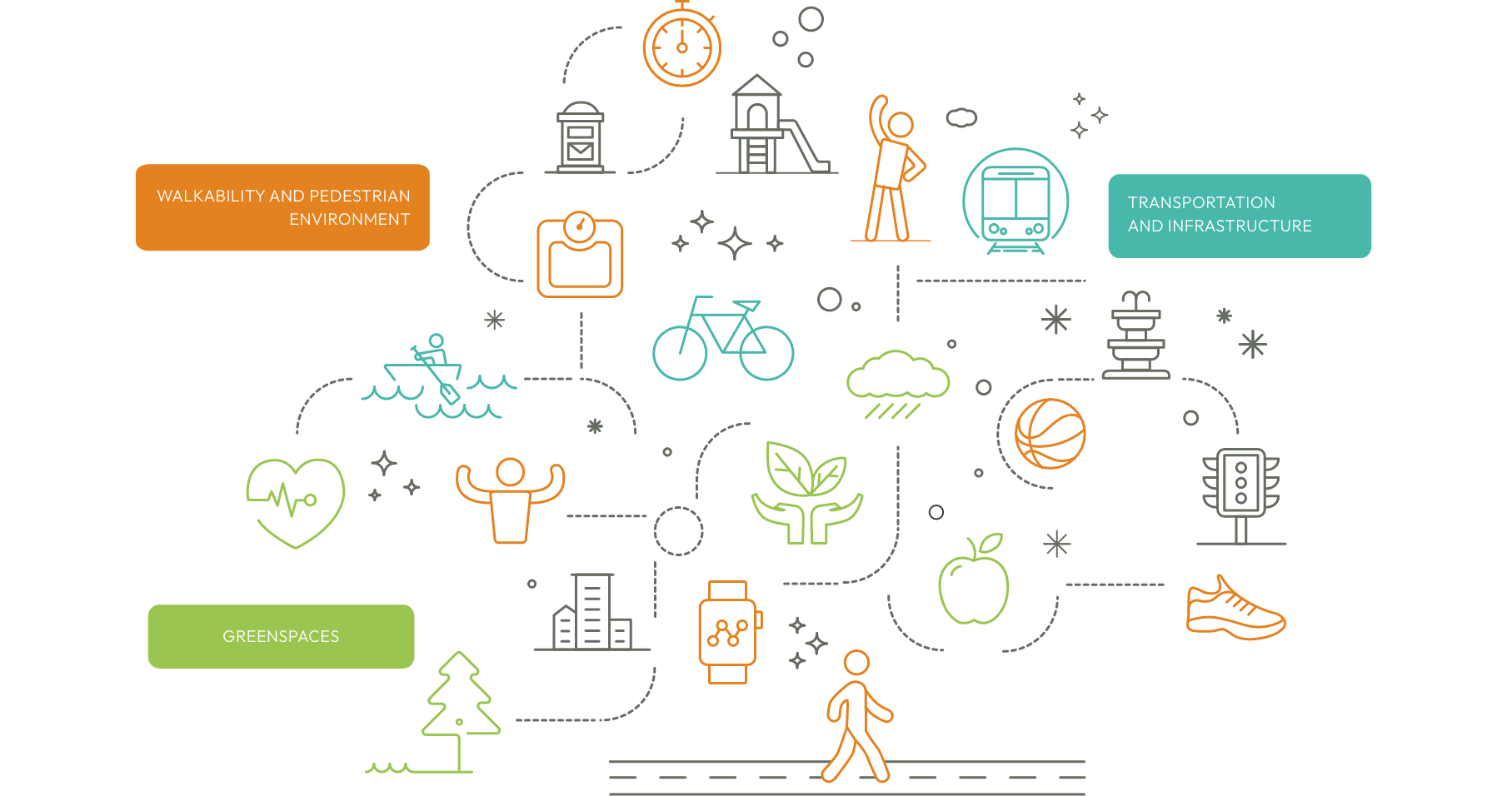Built environment refers to those places built or designed by humans – such as buildings, parks, transportation infrastructure or trails – where people perform their daily lives. There is wide literature confirming that the built environment influences public health in general and NCDs specifically, in terms of enhancement of active lifestyles, adequate diets or reduced exposure to pollution. Physical activity is considered to have a key role on the impact of built environment towards NCDs. In particular, higher walkability in urban areas has been positively associated with walking and physical activity while showing positive effects against cardiovascular risk and diabetes, also in studies conducted with ethnically diverse participants. The main attributes of built environment, which are associated with NCDs, includes the following:
i) Transportation infrastructure, such as public transport networks, walking or bicycle paths;
ii) Walkability, conceptualised as the quality of which the built environment enables the mobility of pedestrians, including pedestrian sidewalks, street connectivity or accessibility to amenities;
and iii) Greenspace, defined as the amount of or proximity to greenness or vegetation, such as parks, forests, fields, and outdoor recreation areas.
These elements have demonstrated to have impacts over cardiovascular diseases and diabetes, as well as in an increase of physical activity, which has demonstrated to be a protective factor against these NCDs. This evidence is shown at the table below:

Transportation infrastructure
- Increased physical activity associated with public transport density.
- Improved cardiovascular health and lower body weight.
- Increased bicycle use derived from the availability of bicycle paths or
- Active transportation derived from the availability of public bus and rail stops impacting individuals being more active, and less likely to be overweight or obese

Walkability and pedestrian environment
- Lower prevalence of obesity and decreased premature mortality.
- Higher predicted 10-year risk of having a cardiovascular event in those neighbourhoods with a low level of walkability.
- Decreased overweight, obesity and diabetes.
- Better health in terms of BMI, systolic and diastolic blood pressure, biomarkers of noncommunicable disease (e.g. lipids for vascular disease) or diagnostic measures (e.g. haemoglobin A1c for diabetes).
- Declined incidence of diabetes in more walkable areas.
- More walking and higher physical activity in neighbours with sidewalks, well-lit streets and pedestrians shielded from traffic

Greenspace
- Protective influence in the development of diabetes by the availability of neighbourhood greenspace.
- Protective associations of green space exposure on cardiovascular events, such as lower risk of mortality or stroke incidence/prevalence.
- Lower prevalence of diabetes in countries with a highly green space environment-
- Availability and proximity of recreation facilities have been associated with greater physical activity.
In this sense, HORUS will consider these three components of the built environment
Transportation infrastructure, Walkability and pedestrian environment, and Greenspace that have demonstrated having an impact on behaviour towards healthy lifestyles that may positively impact the incidence and prevalence of NCDs, especially diabetes and cardiovascular diseases. How these will be considered and approached for the subsequent research activities is explained later in the Methodology section. The role of these elements of the built environment have been also studied considering the population socioeconomic status.
Usually, vulnerable individuals such as low-income communities, migrants, and ethnic minorities living in more socio-deprived areas use to have poorer infrastructures, such as fewer public transport connections, less supportive environmental conditions for active transportation, smaller parks or more trafficked roads. These aspects may fail to encourage the use of the built environment for either physical activity or social interactions. In this line, according to the review done by Adkins et al., the average effect of the built environment on physical activity for disadvantaged groups is 11% compared with 27% for advantaged groups. The same occurs for the effect of BE on leisure walking being less than 1% for disadvantaged groups vs. 6% for advantaged groups.
Available literature shows the relationship between physical-social and functional aspects of the urban built environment and NCD outcomes, as well as the prevalence of related risk factors. However, in-depth research on causal links between urban environmental characteristics, risk behaviours, and NCD outcomes is limited, resulting in a scarce spatial epidemiology of NCDs.
Designing cities from an epidemiological perspective is crucial for reducing risk behaviours and preventing NCD outcomes. Furthermore, we assert that citizen science, participatory strategies, and co-design can synergize with behaviour change, offering effective, inclusive approaches for promoting healthier, sustainable lifestyles.

HORUS aims to tackle NCDs, especially diabetes and cardiovascular diseases, in urban built environments among vulnerable populations, mainly low-income communities, migrants and ethnic minorities. In particular it has a twofold objective:
1) to analyse and explore in depth the causal links between the characteristics of the urban built environment and the prevalence of NCD risk behaviours in an integrated, comprehensive and multi-approach manner. HORUS will focus on existing urban interventions modifying the physical-social and functional characteristics of the built environment with significant impact on the prevalence of risk behaviours and, eventually, NCD outcomes;
2) to develop pilot interventions in three European countries Spain, Croatia and The Netherlands to promote behaviour change towards a healthier lifestyles for empowering vulnerable populations, in particular low-income communities, migrants and ethnic minorities, and that to support citizens in making optimal use of the urban environment they live in while reducing NCD risk behaviours, especially those related to diabetes and cardiovascular diseases.
Therefore, HORUS will respond to both themes Theme 1: Behavioural change interventions and Theme 2: Interventions that focus on modifying the built environment and the challenges presented by the topic: HORIZONHLTH- 2023-DISEASE-03-03: Interventions in city environments to reduce risk of non-communicable disease (Global Alliance for Chronic Diseases – GACD).

